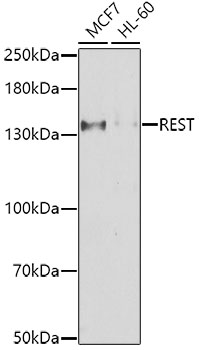-
Product Name
REST Polyclonal Antibody
- Documents
-
Description
Polyclonal antibody to REST
-
Tested applications
WB
-
Species reactivity
Human
-
Alternative names
REST antibody; NRSF antibody; WT6 antibody; XBR antibody; RE1-silencing transcription factor antibody
-
Isotype
Rabbit IgG
-
Preparation
Antigen: Recombinant fusion protein containing a sequence corresponding to amino acids 760-1060 of human REST (NP_001180437.1).
-
Clonality
Polyclonal
-
Formulation
PBS with 0.02% sodium azide, 50% glycerol, pH7.3.
-
Storage instructions
Store at -20℃. Avoid freeze / thaw cycles.
-
Applications
WB 1:500 - 1:2000
-
Validations

Western blot - REST Polyclonal Antibody
Western blot analysis of extracts of various cell lines, using REST antibody at 1:1000 dilution.Secondary antibody: HRP Goat Anti-Rabbit IgG (H+L) at 1:10000 dilution.Lysates/proteins: 25ug per lane.Blocking buffer: 3% nonfat dry milk in TBST.Detection: ECL Basic Kit .Exposure time: 90s.
-
Background
Transcriptional repressor which binds neuron-restrictive silencer element (NRSE) and represses neuronal gene transcription in non-neuronal cells. Restricts the expression of neuronal genes by associating with two distinct corepressors, mSin3 and CoREST, which in turn recruit histone deacetylase to the promoters of REST-regulated genes. Mediates repression by recruiting the BHC complex at RE1/NRSE sites which acts by deacetylating and demethylating specific sites on histones, thereby acting as a chromatin modifier. Transcriptional repression by REST-CDYL via the recruitment of histone methyltransferase EHMT2 may be important in transformation suppression. Key repressor of gene expression in hypoxia; represses genes in hypoxia by direct binding to an RE1/NRSE site on their promoter regions. Negatively regulates the expression of SRRM3 in breast cancer cell lines. Represses the expression of SRRM4 in non-neural cells to prevent the activation of neural specific splicing events (By similarity). Acts as a regulator of osteoblast differentiation (By similarity).
Related Products / Services
Please note: All products are "FOR RESEARCH USE ONLY AND ARE NOT INTENDED FOR DIAGNOSTIC OR THERAPEUTIC USE"
